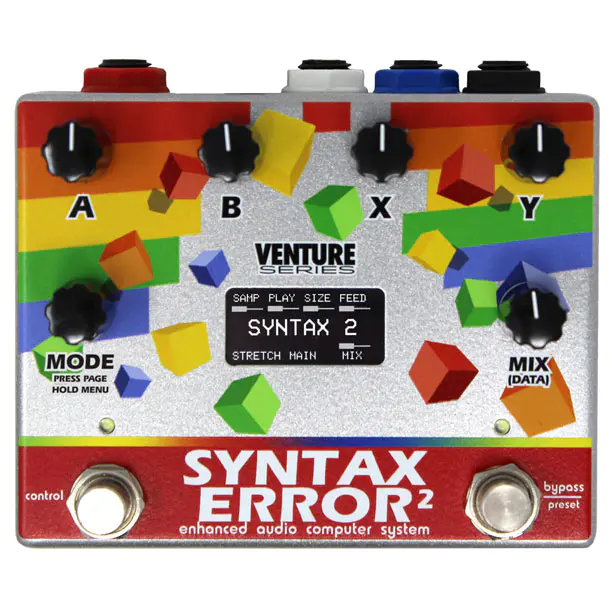
We were the first one to take a picture and report about the Alexander Pedals Syntax Error 2 at Summer NAMM 2021, and we now are excited to see the first demo videos of it!
Twice as wide as the original, this arcade game-inspired pedal packs a ton of new features, including a full stereo path, a mini-sequencer, and an LCD screen to help you make sense of the insane tones it can deliver.
The Six modes sound inspiring:
STRETCH This mode records the input signal into a sample buffer, and then plays it back in real-time. Great for glitchy delay effects, random reverse, or freaky feedback.
AIR Grainy, lo-fi reverb effect similar to very early digital and analogue reverberation devices. Early reflections and slow build times make this a unique textural tool.
RING Balanced “ring” modulation effect, adds extra frequencies to the original tone that are mathematically related but not harmonically related. Wild.
CLUBE Math-based cubic distortion and fuzz effect, with tunable resonant filter.
FREQ Frequency shift effect, adds or subtracts a set frequency from the input signal. Like pitch shift but all of the intervals are broken. It’s horrible.
WAVE Time based modulator, used for chorus, vibrato, flanger, and FM effects.
Each mode has its momentary effect triggered by holding the Ctrl footswitch, which is also used to manually step through the sequence value.
The “Venture Series” tag on top of the display seems to point towards a new template format for other pedals to come – which we can expect to be adventurous ones, as per the moniker.
The big OLED display is the most noticeable upgrade here, but this new series inherits several features already included in the company’s Neo series, like presets, a “Morph” function that allows to seamlessly transition between presets (now also controllable via Expression pedal), and Midi and USB ports.
Matthew from Alexander Pedals revealed in this Reddit thread that this is the first product he designed using the FXCore DSP.
Take a listen to the wonderful sounds concocted by the Alexander Pedals Syntax Error 2 in the following videos, we added it to our article about the Best Glitch and Granular Pedals.
[Wanna get this baby and be supportive? Buy it through our Perfect Circuit affiliate programs – at no extra cost.]
The Alexander Syntax Error 2 is our newest noisemaker, designed to help you create your very own arcade soundtrack using guitar, bass, keys, or whatever. Featuring the powerful new FXCore DSP, Syntax Error 2 packs more power, punch, and possibilities than any other Alexander pedal thus far.
Syntax Error 2 features six sound modes, each of which may be tuned, tweaked, and customized to your heart’s desire.
SOUND MODES:
STRETCH This mode records the input signal into a sample buffer, and then plays it back in real-time. Great for glitchy delay effects, random reverse, or freaky feedback.
AIR Grainy, lo-fi reverb effect similar to very early digital and analogue reverberation devices. Early reflections and slow build times make this a unique textural tool.
RING Balanced “ring” modulation effect, adds extra frequencies to the original tone that are mathematically related but not harmonically related. Wild.
CLUBE Math-based cubic distortion and fuzz effect, with tunable resonant filter.
FREQ Frequency shift effect, adds or subtracts a set frequency from the input signal. Like pitch shift but all of the intervals are broken. It’s horrible.
WAVE Time based modulator, used for chorus, vibrato, flanger, and FM effects.
PRESETS
Eight built-in presets give you loads of tones in a single footprint. Add a MIDI controller for up to 32 presets.OLED DISPLAY
Graphical display shows your current preset, knob values, sequencer status, and more.EXP MORPH
Seamlessly morph between different knob settings on the fly using an expression pedal or MIDI controllerMINI SEQUENCER
Versatile and powerful four-step sequencer can control any one of the pedal knobs. Great for creating animated textures, arpeggios, LFO effects, and more.STEREO
Advanced stereo routing capabilities, selectable in the global configuration menu. Choose Mono, Stereo Summing, or Stereo. Separate dry output is available in Mono and Stereo Sum modes, and the R / Dry output phase may be inverted to correct phase issues.






















